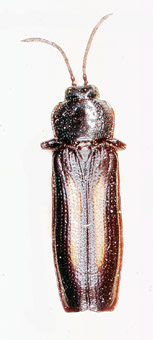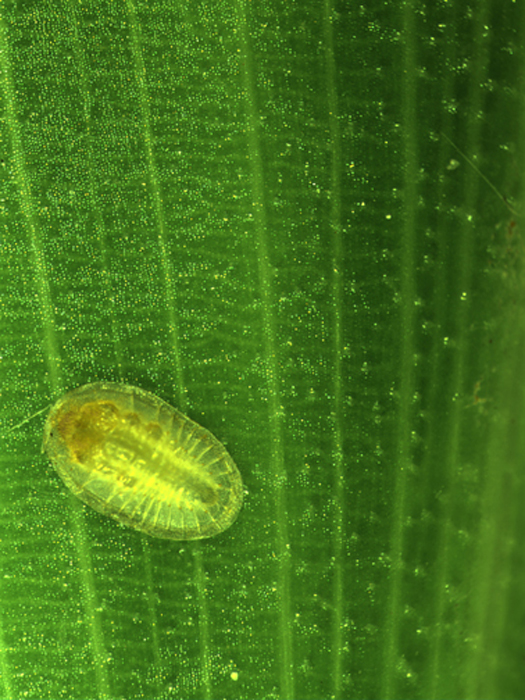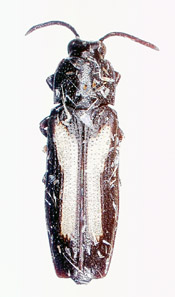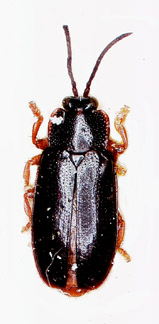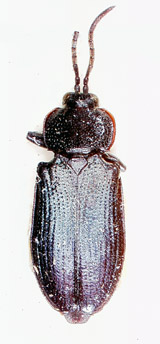Cephaloleia
Introduction
Cephaloleia Chevrolat (Coleoptera: Chrysomelidae: Cassidinae) contains 212 species from Central and South America; the entire genus was revised (Staines & García-Robledo (2014)). Staines (1996, 1998, 2008, 2009) has studied the 87 species known from Central America and the West Indies. Most Cephaloleia feed on plants in the order Zingiberales but a few species attack various other plant families. Four species have been associated with palms.
Distribution
Cephaloleia depressa Baly is found in Brazil (Santarem).
Cephaloleia elaeidis Maulik is found in Brazil (Bahia).
Cephaloleia formosus Staines is found in Panamá.
Cephaloleia vagelineata Pic is found in Colombia.
Hosts
Cephaloleia depressa feeds on Elaeis guineensis Jacq. (Arecaceae) (Mariau 2001).
Cephaloleia elaeidis feeds on Elaeis guineensis Jacq. and Geonoma sp. (Arecaceae) (Maulik 1924).
Cephaloleia formosus feeds on Elaeis guineensis Jacq. (Arecaceae) (Staines 1996).
Cephaloleia vagelineata feeds on Elaeis guineensis Jacq., Corozo oleifera (H.B.K.) Bailey, Cocos nucifera L. (Sandino 1972); and Astrocaryum chonta Matrius (Couturier & Kahn 1992) (Arecaceae).
Damage
The larvae of C. vagelineata feed on the basal part of the rachis. Attacked areas become gray or brown as they wither causing necrotic areas. Adults feed on the parenchyma of young leaves while they are still half open. Damage appears as longitudinal grooves which in heavy infestations can fuse into each other. The species is suspected of being associated with the bud rot fungus (see bud rot fact sheet at http://itp.lucidcentral.org/id/palms/symptoms/Bud_Rot.htm) (Sandino 1972).
Life history notes
Eggs of C. vagelineata are yellow, flat, and elliptical; they are 2 mm long and are laid individually on the inside of the rachis and young leaves. Larvae develop in the moist environment which aids their development. Pupation occurs at the base of the leaves (Sandino 1972).
Bibliography
Couturier, G. & F. Kahn. 1992. Notes on the insect fauna on two species of Astrocaryum (Palmae, Cocoeae, Bactridinae) in Peruvian Amazonia, with emphasis on potential pests of cultivated palms. Bulletin de l’Institut Français d’Etudes Andines 21 (2): 715-725.
Mariau, D. 2001. The fauna of oil palm and coconut. Insect and mite pests and their natural enemies. Cirad. Montpelier, France. 249 pp.
Maulik, S. 1924. A new hispid beetle injurious to oil palms in Brazil. Bulletin of Entomological Research 14: 245-246.
Sandino, E. U. 1972. Cephaloleia sp. cerca a vagelineata Pic, una plaga de la palma Africana. Revista Facultad Nacional de Agronomia Medellin 27 (2): 75-77.
Staines, C. L. 1996. The genus Cephaloleia (Coleoptera: Chrysomelidae) in Central America and the West Indies. Special Publication No. 3 of the Revista de Biología Tropical. 87 pp.
Staines, C. L. 1998. A new species of Cephaloleia Chevrolat (Coleoptera: Chrysomelidae: Hispinae) from Costa Rica. Proceedings of the Washington Entomological Society 100: 672-673.
Staines, C. L. 2008. A new species of Cephaloleia Chevrolat, 1837 (Coleoptera: Chrysomelidae: Cassidinae) from Dominica. Insecta Mundi 0030: 1-4.
Staines, C. L. 2009. Generic reassignment of species in the tribe Cephaloleiini Chapuis, 1875 (Coleoptera: Chrysomelidae: Cassidinae). Insecta Mundi 0107: 1-4.
Staines, C. L. 2012. Tribe Imatidiini. Catalog of the hispines of the world (Coleoptera: Chrysomelidae: Cassidinae). http://entomology.si.edu/Collections_Coleoptera.html
Staines, C. L. & C. García-Robledo. 2014. The genus Cephaloleia Chevrolat, 1836 (Coleoptera: Chrysomelidae: Cassidinae). Zookeys 436: 1-355.


